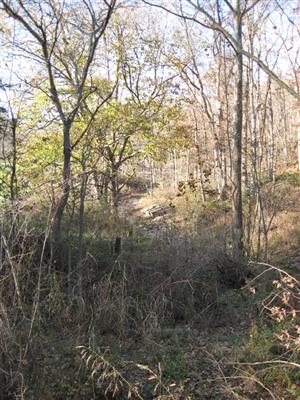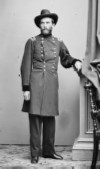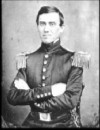 Directions: The First Federal Roadblock [ Waypoint = N36 28.599 W94 02.852 ] was located approximately 1.3 miles past Twelve Corners Church along the Bentonville Detour.
Directions: The First Federal Roadblock [ Waypoint = N36 28.599 W94 02.852 ] was located approximately 1.3 miles past Twelve Corners Church along the Bentonville Detour.As you drive along the Bentonville Detour, you will pass two locations where the Federals cut down trees to act as roadblocks against an enemy force in their rear.

Description: This was the first location where the Federals cut down trees to act as roadblocks against an enemy force in their rear. Because the ravine was so steep, The confederates would have found it difficult to simply go around the roadblock. Rather, they would have had to taken the time to cut a path through the felled trees.
Directions: The Second Federal Roadblock [ Waypoint = N36 29.193 W94 01.740 ] was located approximately 2.8 miles past Twelve Corners Church along the Bentonville Detour.
 Description: This was the second location where the Federals cut down trees to act as roadblocks against an enemy force in their rear. Again, the confederates would have had to taken the time to cut a path through the felled trees.
Description: This was the second location where the Federals cut down trees to act as roadblocks against an enemy force in their rear. Again, the confederates would have had to taken the time to cut a path through the felled trees.
The felling of trees along the Bentonville Detour was the work of Colonel Grenville Dodge's 1st Brigade. He took units from the 4th Iowa Infantry and 3rd Illinois Cavalry and quickly established roadblocks along the detour. While they were working on the second roadblock closer to Cross Timber Hollow, they heard a lot of noise coming from near where they had place the first roadblock. Colonel Dodge hurried his force back to the fortifications at Little Sugar Creek and reported the enemy activity to General Curtis. Curtis did not believe it was anything more than a Southern scouting party.
Union Colonel Eugene A. Carr wrote about the work of Dodge's Brigade in his official report:
“Colonel Dodge, with a large part of his brigade, by special direction of the general, had been out the night before the battle until 12 o'clock, blockading the road by which the enemy traveled an hour or two afterwards to get in our rear. This blockading delayed the enemy and was of great advantage to us.”
Union Brigadier General Samuel R. Curtis would confirm the effectiveness of these roadblocks in his official report:
“The Third and Fourth Divisions had before noon of the 6th deployed their lines and cut down a great number of trees, which thoroughly blockaded the roads on the left. Later in the day I directed some of the same work to be done on the right. This work was in charge of Colonel Dodge, who felled trees on the road which runs parallel to the main road to which I have before referred. This proved of great advantage, as it retarded the enemy some two hours in their flank movement.”
 Confederate Colonel Henry Little described the impact of these roadblocks:
Confederate Colonel Henry Little described the impact of these roadblocks:
“At 8 o'clock our line of march was resumed and continued all night. Once about midnight and again towards morning our progress was checked by an ex tempore blockade of the road, the enemy having felled the timber behind him as he retreated."
"By 6 a. m. on the 7th we had cleared the road of every impediment, and by 8 o'clock we reached and secured possession of the Telegraph road at a point about half a mile to the north of the enemy's position, thereby cutting off his retreat. ”